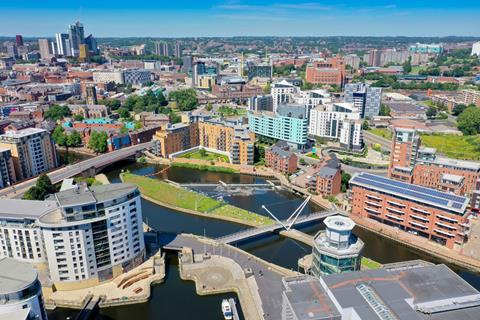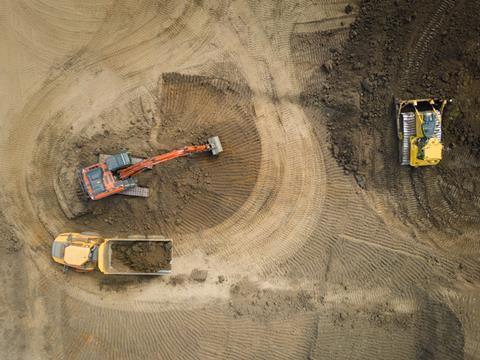We’ve got to start now. And if we get tied up in bureaucracy, we won’t build anything, writes John Rayson, director northern transformation programme, AtkinsRéalis
Change is sorely needed across the UK. And a new holistic approach to development and investment offers to provide it.
Place-led growth looks beyond traditional measures of growth to tie together the bigger picture - from housing to skills, infrastructure to natural capital, and health to economic growth, and integrating it with local aspirations to foster sustainable and inclusive development.
Unfortunately, socio-economic inequalities remain entrenched across the UK. Despite an unprecedented amount of effort and funding to tackle them over the last five years, there’s still a great deal of work to do.

But take a panoramic view of the nation and its progress in that time, and you’ll witness a nascent reality slowly but steadily taking hold. Because ‘Levelling Up’ has opened up and widened a vital conversation. We’re thinking about growth differently, and that’s a profound shift with profound consequences.
What we’re now talking about, and starting to deliver, is place-led growth.
Place-led growth reflects a changing understanding of what growth should be. In contrast to the often ineffectual top-down efforts to catalyse meaningful change over the last decade, it’s founded on placing the citizen and the environment at the heart of projects.
By aligning economic progress - what used to be seen as the primary driver of successful growth - with a more holistic picture of infrastructure development, social value creation, skills enhancement and environmental stewardship, it represents a huge opportunity to actually nurture thriving places, for thriving people.
Whatever happens at the next election, place-led growth is here to stay.
In part because of persistent demands for deepening devolution from communities and combined authorities, and in part because a changing climate is forcing us to embrace sustainability, it will define the next chapter of the UK’s story.

But there’s a catch: one that will define that chapter’s success. Delivering holistic growth is extremely complex, thanks to the intricate interplay of dynamic factors that shape the prosperity and well-being of communities. If we’re to make place-led growth work, we have to start changing our legacy ways of thinking.
Fuel needed
Start with the first vital ingredient - funding.
It’s clear that a significant leap is required to move from years of deprivation, disconnected development, and siloed approaches to a unified, connected and flourishing ecosystem.
It’s not solely about the size of financial contributions, it’s also about deploying resources strategically across the whole system to maximise their impact, seizing opportunities for co-benefits.
Can biodiversity net gain also enhance flood resilience, for instance? Or can investment in green space benefit the local environment and a community’s health and wellbeing?

In today’s landscape, traditional funding models often fall short in seeing and understanding these diverse, interrelated needs.
So while we must explore alternative avenues to tap into the reservoirs of capital held by institutions like investment banks and pension funds, and initiate more public-private partnerships to make better use of existing resources, we must also ensure funding connects to wider forms of capital - building skills, investing in people’s health, and harnessing natural capital.
That will require careful expertise in creating strong, far-sighted and multidimensional business cases that replace uncertainty with confidence and clarity.
Re-valuing social value
At the core of place-led growth lies the imperative to enhance the quality of life for our communities.
Because it’s now widely understood that growth, especially in our democracy, will only really succeed in meaningful terms when it meets people’s needs. Yet our cultural backdrop is changing all the time.

Five years ago, who might have guessed that our research would tell us that the next generation would embrace the high street, prefer the gym to the pub or champion the renewal of community centres?
What’s less surprising is that young people don’t feel well prepared for the job market of the future. That is what has prompted us in 2024 to partner with the N8 universities, eight leading research-intensive universities in the North, to research innovation and place-led growth.
Furthermore, we must therefore redefine our notions of social value, thoroughly embed engagement with communities to understand needs, and apply a defibrillator to improve the beating heart of towns and cities.
That’s how we’ll boost investment and align investment priorities with what matters to communities, such as active travel, sustainable living, vibrant public spaces, and social cohesion.
In turn, it’s key to developing capabilities and training opportunities, enhancing connectivity through transportation and ultimately, retaining people in communities - still a huge problem across the country.
Coordinating the rush to devolution
Excitingly, devolution is genuinely beginning to accelerate through Trailblazer schemes in Manchester and the West Midlands.
But devolution alone does not guarantee success, nor does the amalgamation of local authorities into combined authorities. If the system for developing business cases for public sector funding does not enable those authorities to undertake a holistic assessment and account for of all of the benefits available across their areas, then we will go back to square one.
Or if plans are too ambitious, or too simplistic, they might be tough to realise. That’s why robust governance frameworks that properly engage and involve private sector companies are essential.
Across a range of areas - life sciences, net zero, and AI - the UK has a real opportunity to progress world-leading industries, and develop many that are just buds right now, such as green hydrogen, carbon capture storage and green manufacturing.

Executed effectively, devolution is the key to diversification and innovation in these areas and more. In essence, we’ll be creating a network of laboratories testing hypotheses simultaneously in different conditions.
The result will be a burst of energy and ideas, cross-sectoral and cross-regional collaboration, and a natural decentralisation and democratisation of intelligence and skills.
The UK has long struggled with sluggish productivity, but devolution is a potential antidote - bringing decision-making closer to home and closer to the priorities of those who live there. That’ll be good for communities, and good for the big picture.
Outward responsibilities
A few years ago, AtkinsRéalis was challenged to become an employer of choice. And the reason we succeeded was that we understood that careers are not just about money, they’re about the right culture, the right career paths, clear succession plans and transparency.
We now want to disseminate that way of thinking to the wider culture - improving visibility, demonstrating what our direction could be, and shining a light on the opportunities. For too long, it’s been easy to be pessimistic because that picture was too opaque.
“Unless we can join the dots across the whole value chain (from consulting to capital to project delivery, and asset management to decommissioning) we’re likely to remain stuck in a cycle of insufficient investment and unremarkable performance.”
John Rayson, director northern transformation programme, AtkinsRéalis
That’s why we want to play our part locally and nationally, using our scale to reach younger people, place governors into schools, and challenge perceptions around STEM.
More widely, we want to leverage our end-to-end expertise across a wealth of technical disciplines to integrate disparate sets of knowledge, from finance to foundation engineering, into cohesive strategies, plans, and delivery.
Unless we can join the dots across the whole value chain (from consulting to capital to project delivery, and asset management to decommissioning) we’re likely to remain stuck in a cycle of insufficient investment and unremarkable performance.
A collaborative endeavour
Ultimately, the success of place-led growth hinges on collaboration - a concerted effort that brings together stakeholders from various sectors. Whether it’s local authorities, private enterprises, or academic institutions, each plays a vital role in shaping the future of our communities.
It’s still early days, and there’s still a long way to go to work out how many of these dynamic elements such as devolution will play out. But we know the ingredients, and can start connecting them. We’ve got to start now. And if we get tied up in bureaucracy, we won’t build anything.

Place-led growth will no doubt hit some bumps to adoption, from strategy to implementation.
But the desired outcome is optimistic, holistic, and realistic; to kickstart a virtuous cycle of economic growth and social value begetting increased diversity, confidence and opportunities, leading to a more skilled population and thriving places, in turn generating further economic growth and social value.
To do this will require imagination, tenacity, and creativity. Time, then, to roll up our sleeves and get to work.


























